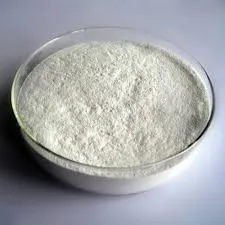
Nov . 26, 2024 12:55 Back to list
Manufacturing Process for Redispersible Polymer Powders An Overview and Insights
Manufacturing Process of Redispersible Polymer Powder
Redispersible polymer powder (RDP) is an essential component in various construction and adhesive products, offering enhanced performance characteristics such as improved adhesion, flexibility, and water resistance. The manufacturing process of redispersible polymer powder is multifaceted and involves several crucial steps to ensure a high-quality product that meets industry standards. This article outlines the key stages in the production of RDP, from polymerization to drying and packaging.
1. Polymerization
The production of redispersible polymer powder begins with the polymerization process. This is where the raw materials, including monomers such as vinyl acetate, ethylene, and acrylates, are transformed into a polymer. The polymerization process can be carried out through different methods, including emulsion polymerization, solution polymerization, or suspension polymerization.
Emulsion Polymerization
Emulsion polymerization is the most commonly used method for creating RDP. This process involves the dispersion of monomers in water, stabilized by surfactants. An initiator is added to trigger polymerization, resulting in the formation of polymer particles dispersed in water. This method is preferred because it allows for better control of particle size and distribution, yielding polymers with desired properties that will ultimately affect the performance of the redispersible powder.
2. Stabilization and Post-Processing
Once the polymer is synthesized, the next step is stabilization. Stabilizers or protective colloids are often added to prevent the polymer from aggregating and to maintain its stability during the drying process. This step is crucial as it ensures that the polymer remains intact and functional throughout the subsequent stages and during storage.
Post-processing may also involve adjusting the pH of the polymer dispersion, modifying the viscosity, or incorporating additional additives to achieve specific performance characteristics. This flexibility is key in tailoring the properties of the final redispersible polymer powder to meet diverse application needs.
3. Drying
The drying process is critical in converting the liquid polymer dispersion into a dry powder form. This is typically achieved through spray drying or freeze-drying.
redispersible polymer powder manufacturing process

Spray Drying
In spray drying, the polymer emulsion is atomized into fine droplets and then introduced into a hot air chamber. The rapid evaporation of water results in the formation of dry polymer particles. This technique is favored for its efficiency and ability to produce powders with consistent particle size and distribution.
Freeze-Drying
Alternatively, freeze-drying (lyophilization) can be employed, which involves freezing the polymer emulsion and then reducing the surrounding pressure to allow the frozen water to sublimate. Although this method is more time-consuming and expensive, it is advantageous for producing highly porous powders with unique properties.
4. Milling and Sieving
After drying, the polymer powder may contain agglomerates that need to be broken down to ensure a uniform particle size. This is achieved through milling and sieving processes. Milling helps to reduce the size of the powder, while sieving eliminates large particles and ensures consistency in the final product. Achieving the right particle size is essential, as it influences the re-dispersibility of the powder during application.
5. Packaging and Quality Control
The final step in the manufacturing process involves packaging the redispersible polymer powder for distribution. Packaging must be done in moisture-proof bags to maintain the integrity of the product during storage and transportation. Quality control measures are implemented throughout the manufacturing process, including monitoring the polymerization reaction, assessing the physical and chemical properties of the powder, and conducting re-dispersibility tests to ensure that the RDP performs as expected in end-use applications.
Conclusion
In summary, the manufacturing process of redispersible polymer powder is a complex sequence of steps that involves polymerization, stabilization, drying, milling, and packaging. Each phase is carefully controlled to produce a high-quality product that meets the demands of various applications in the construction and adhesive industries. As innovation continues to evolve in polymer technology, the methodologies employed in RDP manufacturing will likely adapt, leading to enhanced performance and broader application potential.
-
Versatile Hpmc Uses in Different Industries
NewsJun.19,2025
-
Redispersible Powder's Role in Enhancing Durability of Construction Products
NewsJun.19,2025
-
Hydroxyethyl Cellulose Applications Driving Green Industrial Processes
NewsJun.19,2025
-
Exploring Different Redispersible Polymer Powder
NewsJun.19,2025
-
Choosing the Right Mortar Bonding Agent
NewsJun.19,2025
-
Applications and Significance of China Hpmc in Modern Industries
NewsJun.19,2025







